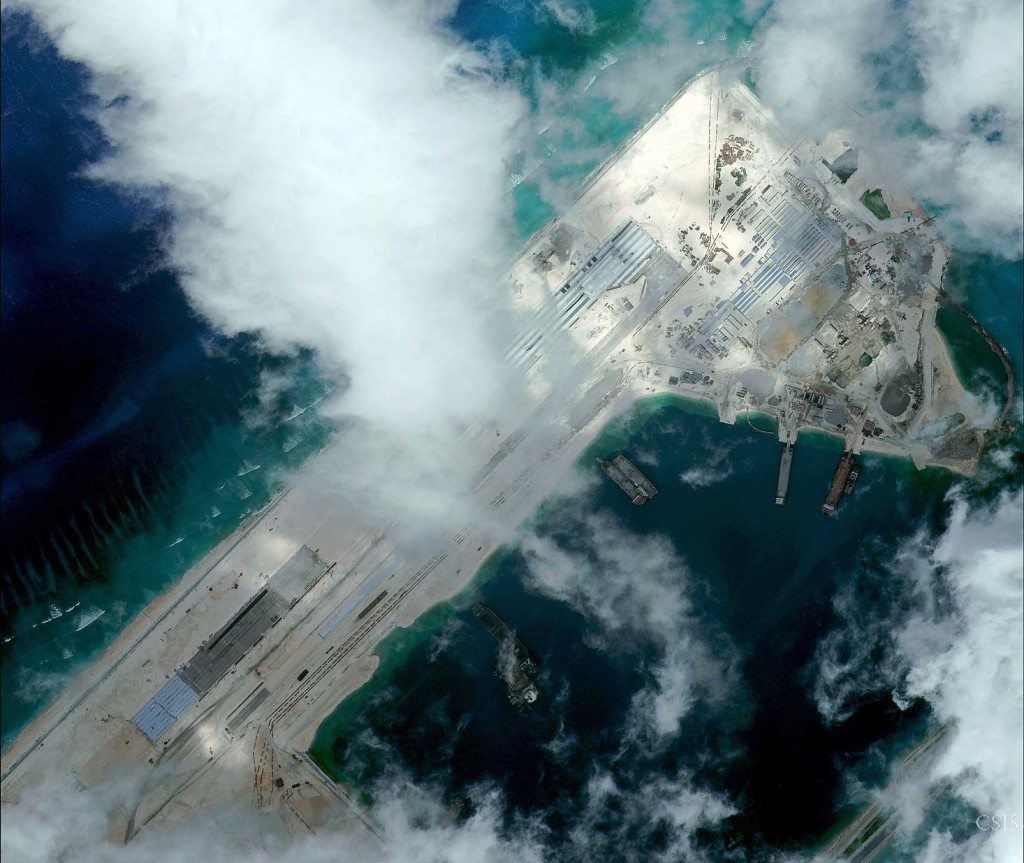ΣΧΟΛΙΟ ΙΣΤΟΛΟΓΙΟΥ : Αυτήν την φορά δεν θα σας σώσει κανείς. Ούτε η Ρωσία έχει την διάθεση να μπει στο κλουβί με τον Κινέζικο Δράκο, για να σας γλυτώσει, ούτε ουδείς άλλος. Και αυτήν την φορά θα ματώσετε από την αρχή και όχι στο τέλος του πολέμου, όπως στον Β.Π.Π και στον Α΄Π.Π. Στην ερώτηση ποια χώρα θα μπορούσε να εισβάλλει η να τα βάλλει με την Κίνα και να νικήσει....η απάντηση μου είναι...κατά πρώτον κάποια που ΔΕΝ χρειάζεται να το κάνει και κατά δεύτερον, κάποια που μπορεί να εγκαταστήσει έναν ΝΑΥΤΙΚΟ ΑΠΟΚΛΕΙΣΜΟ και μετά να καθίσει να απολαύσει την Κίνα να καταρρέει. Στο σημερινό στάδιο που βρίσκεται η Κίνα αρκεί και μόνο 3 ναυτικές δυνάμεις από τις 5 που υπάρχουν στον πλανήτη να κάνουν μια χαρά την δουλειά. Επιπλέον η αδυναμία προστασίας των συμφερόντων της σε κάποιο πολύ συγκεκριμένο γεωγραφικό σημείο, δεν της επιτρέπει εκεί να προστατεύσει τα συμφέροντά της. Αντ' αυτού την βοηθάει η Ρωσία να το πράξει. Βέβαια όλα αυτά μπορούν να αλλάξουν μέσα σε μια γενιά...και αυτό η Κίνα το γνωρίζει για αυτό τρέχει να προλάβει...τον ΝΑΥΤΙΚΟ ΑΠΟΚΛΕΙΣΜΟ.
Ο Αχιλλέας θα καθίσει αμέριμνος και θα περιμένει....όσο διαβάζει την Intependent "The US could lose a future war against Russia or China, a new report to Congress has suggested. "
Και αυτό εδώ ..." We've watched them [China and Russia] test those capabilities," Hyten told Congress last week. But with unusual public candor about potential US military shortfalls, he acknowledged "we don't have any defense that could deny the employment of such a weapon against us, so our response would be our deterrent force, which would be the triad and the nuclear capabilities that we have to respond to such a threat."....είπαμε δίχως Αχιλλέα Τροία-Κίνα δεν πέφτει.!!
The militarization of the vital waterway for commercial shipping has been a major concern of Washington and its Asian neighbors for the past several years. But China’s increasingly aggressive challenges of American naval vessels operating in what the US and its allies consider international waters — including a near collision of two ships in September — raises the specter of a deadly accident that might escalate into war. And if a war breaks out, the island bases become a strategic southward extension of China’s land-based defense against US ships and planes, known in the trade as Anti-Access/Area Denial (A2/AD).
As China builds more warships for its navy and continues to militarize its coast guard, Beijing has already dwarfed the fleet the United States can commit to the region, at least if you’re counting the number of hulls in the water. (Many of the Chinese ships are smaller, shorter-range coastal vessels, however). So, after the chief of Indo-Pacific Command (INDOPACOM), Adm. Philip Davidson, spoke to the annual Halifax Security Conference here, I asked him how he plans to keep up.
“We need a bigger Navy,” he said, noting how Navy leaders have repeatedly called for growing the fleet from 286 ships today
to a 355-ship fleet. As the Chinese fleet continues to grow, he told
me, “the capacity concern is going to become a greater concern in years
to come.”
Aegis Ashore
One way to free up more ships to counter China across the Pacific, Navy leadership says, is to shift the ballistic missile defense mission from Aegis cruisers and destroyers at sea to Aegis Ashore batteries and other systems on land. That’s something both the current Chief of Naval Operations, Adm. John Richardson , and his predecessor, Adm. Jonathan Greenert, have advocated for years.
(It’s also taking a page from the Chinese playbook of emplacing long-range missile batteries on islands, even if you have to build the island first. China’s extensive arsenal of land-based missiles was one of the major factors driving the Trump Administration to withdraw from the 1987 INF Treaty with Russia so the US could build its own).
Davidson said his boss “wants to restore maneuverability back to the Navy” by shifting ballistic missile defense onshore. That would the Aegis cruisers and destroyers load their multi-purpose Vertical Launch Systems with other kinds of missiles — say, Tomahawk cruise missiles or LRASM anti-ship missiles, instead of a preponderance of SM-3 anti-ballistic missile interceptors — and range freely across the vast Pacific, instead of plowing the waves back and forth near the cities they’re protecting.
The Aegis system was originally created to defend the fleet against large-scale Soviet air and missile attack: The rise of the Chinese military
has brought this threat back to life, so the Nay wants to get its Aegis
ships back to their original mission. “Those systems still have plenty
of utility at sea defending against anti-ship ballistic missiles in the
future, [including] ballistic missiles in space,” Davidson said. “We’ll
need that against future threats that will threaten sea-based forces.”
Japan has already agreed to buy two Aegis Ashore systems, which will provide “essentially national missile defense for Japan,” Davidson said.

Earlier this year, Japan issued a $2 billion request for two ground-based Aegis Ashore radar missile tracking stations built by Lockheed Martin. The Japanese navy already operates the ship-borne version of the system, while Romania and Poland are the only other countries to have built the ground-based system.
According to current plans, the Aegis Ashore units won’t be operational until 2025. When active, they will be able to link up with the ship-based systems to provide a deeper defense against North Korean missiles.
While China is building new ships,
aircraft carriers and submarines at breakneck pace — last year, the
Chinese navy became the world’s largest — Davidson also has his eye on
Russian moves in the region.
“While most of Russia’s malign activity occurs in other areas of the world, Russia is indeed increasingly active in the Pacific and it often seeks to block and disrupt the diplomatic efforts of others” in the region, he said, noting that Moscow has deployed three of its newest ballistic missile submarines to the Pacific over the past several years.
Russian capabilities in the Pacific are relatively modest, however, and Moscow has no plans to try to challenge the US or China for dominance of the seas in the region.
ΠΗΓΗ
Ο Αχιλλέας θα καθίσει αμέριμνος και θα περιμένει....όσο διαβάζει την Intependent "The US could lose a future war against Russia or China, a new report to Congress has suggested. "
Και αυτό εδώ ..." We've watched them [China and Russia] test those capabilities," Hyten told Congress last week. But with unusual public candor about potential US military shortfalls, he acknowledged "we don't have any defense that could deny the employment of such a weapon against us, so our response would be our deterrent force, which would be the triad and the nuclear capabilities that we have to respond to such a threat."....είπαμε δίχως Αχιλλέα Τροία-Κίνα δεν πέφτει.!!
From militarized atolls in the South China Sea to a growing Chinese navy looking increasingly aggressive, the head of the Indo-Pacom command lays out his needs and concerns.
HALIFAX: By turning reefs and atolls in the disputed South China Sea into fortified artificial islands, complete with anti-aircraft Surface-to-Air Missiles, China has transformed “what was a great wall of sand just three years ago [into] a great wall of SAMs,” the US commander in the Pacific said here today.The militarization of the vital waterway for commercial shipping has been a major concern of Washington and its Asian neighbors for the past several years. But China’s increasingly aggressive challenges of American naval vessels operating in what the US and its allies consider international waters — including a near collision of two ships in September — raises the specter of a deadly accident that might escalate into war. And if a war breaks out, the island bases become a strategic southward extension of China’s land-based defense against US ships and planes, known in the trade as Anti-Access/Area Denial (A2/AD).
As China builds more warships for its navy and continues to militarize its coast guard, Beijing has already dwarfed the fleet the United States can commit to the region, at least if you’re counting the number of hulls in the water. (Many of the Chinese ships are smaller, shorter-range coastal vessels, however). So, after the chief of Indo-Pacific Command (INDOPACOM), Adm. Philip Davidson, spoke to the annual Halifax Security Conference here, I asked him how he plans to keep up.
Aegis Ashore
One way to free up more ships to counter China across the Pacific, Navy leadership says, is to shift the ballistic missile defense mission from Aegis cruisers and destroyers at sea to Aegis Ashore batteries and other systems on land. That’s something both the current Chief of Naval Operations, Adm. John Richardson , and his predecessor, Adm. Jonathan Greenert, have advocated for years.
Davidson said his boss “wants to restore maneuverability back to the Navy” by shifting ballistic missile defense onshore. That would the Aegis cruisers and destroyers load their multi-purpose Vertical Launch Systems with other kinds of missiles — say, Tomahawk cruise missiles or LRASM anti-ship missiles, instead of a preponderance of SM-3 anti-ballistic missile interceptors — and range freely across the vast Pacific, instead of plowing the waves back and forth near the cities they’re protecting.
Japan has already agreed to buy two Aegis Ashore systems, which will provide “essentially national missile defense for Japan,” Davidson said.

An Aegis Ashore command center, as shown here, is essentially an Aegis warship’s bridge transplanted to land.
According to current plans, the Aegis Ashore units won’t be operational until 2025. When active, they will be able to link up with the ship-based systems to provide a deeper defense against North Korean missiles.
“While most of Russia’s malign activity occurs in other areas of the world, Russia is indeed increasingly active in the Pacific and it often seeks to block and disrupt the diplomatic efforts of others” in the region, he said, noting that Moscow has deployed three of its newest ballistic missile submarines to the Pacific over the past several years.
Russian capabilities in the Pacific are relatively modest, however, and Moscow has no plans to try to challenge the US or China for dominance of the seas in the region.
ΠΗΓΗ


Δεν υπάρχουν σχόλια:
Δημοσίευση σχολίου